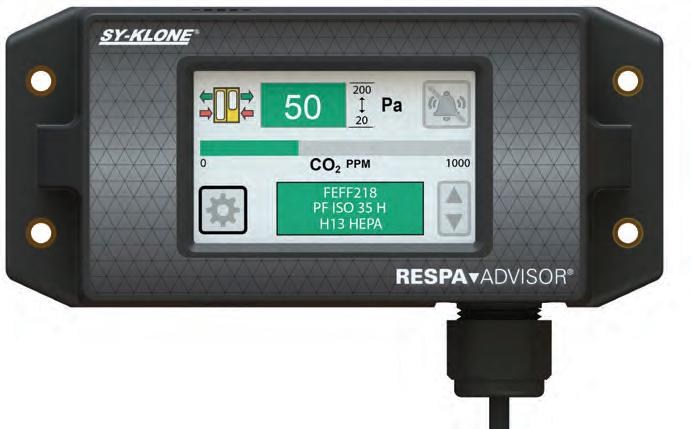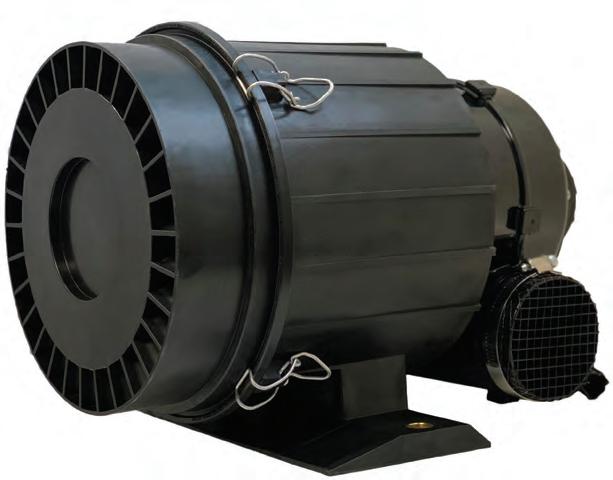
5 minute read
In-cabin monitoring and filtration
from STW Jul 2021
by Prime Group
Technology Meet safety goals with in-cabin monitoring and filtration innovations
Meeting exposure reduction targets is a primary health and safety initiative, as well as an overall industry goal, for mining companies.
Exposure to respirable dust may cause short-term health issues, increased incidences of long-term chronic lower lung disease, and even death.
Reducing occupational exposure has the ability to improve worker health, increase company productivity and reduce employer healthcare costs.
Environmental health and safety officers are partnering with maintenance, repair and operations teams to update new machine tenders, as well as retrofit existing fleets of heavy-equipment cabins, with engineering controls that comply with standards designed to reduce exposure to respirable particulate.
New clean air innovations are providing additional engineering control options that isolate workers from hazards and are more effective than administrative controls, which focus on changing the way people work and/or personal protective equipment (PPE).
In addition, a new standard – ISO 23875 cabin air quality standard – provides practical steps for mine sites to improve engineering controls and operational integration of machine cabs, in support of reducing occupational exposure and improving worker health.
ISO 23875 seeks to “address the fundamental design requirements that will allow for operator enclosures to perform at a level that provides sustained air quality, reducing concentrations of respirable particulate matter and carbon dioxide that are harmful to human health.”
Safe to Work examines the landscape of new products and identifies three air-quality trends that have emerged to help sites protect machine operators. The trends include cabin pressurisation impact on exposure reduction, the hidden dangers of CO2 and the importance of recirculation on maintaining air quality in cabins.
The RESPA PURE is an in-cabin filtration system that does not require adaptation or plumbing.
CABIN PRESSURISATION REDUCES EXPOSURE
New machines and existing fleets of equipment need a properly sealed cabin that can maintain pressurisation.
A properly sealed cabin is the first step to maintaining good air quality, as loss of cabin pressure can allow harmful respirable particulate to enter the cabin.
Monitoring cabin pressure can be achieved through in-cabin monitoring devices. The in-cabin monitor provides machine operators real-time visibility into pressurisation levels, which can be a good indicator of both cabin air quality and filter life.
THE HIDDEN DANGERS OF CO2
Operator fatigue is a major contributor to near misses and accidents on industrial job sites. Unsafe levels of CO2 in confined spaces, such as a machine cabin, are a contributor to operator fatigue and may lead to drowsiness and loss of concentration or mental acuity.
Implementing safety controls to alert machine operators to unsafe conditions is important to maintaining a safe working environment. Safety controls should include both audible and visual alarms to notify operators when conditions are outside defined limits.
New generations of in-cabin monitors alert a machine operator when CO2 levels increase beyond safe limits.
When selecting an in-cabin monitor for CO2 monitoring, it is important to choose a device that includes a highquality CO2 sensor to ensure accuracy, real-time visibility to air-quality conditions and compliance with industry standards, such as ISO 23875.
The latest standout in-cabin monitor for heavy machinery and fixed plant cabins is his company’s RESPA Advisor+. The RESPA Advisor+ is the only ISO 23875-compliant in-cabin pressure and CO2 monitor on the market.
Sy-Klone International sales and marketing vice president Austin Browne recommends that “every cabin airquality system include a monitor to ensure machine operators have visibility to the condition of the air quality inside of their cabin.”
“Monitors provide fact-based datapoints for machine operators, health and hygiene officers, and maintenance leaders to better manage cabin air quality systems, resulting in improved operator air quality, reduced occupational exposure, compliance with industry standards, and more consistently meeting defined maintenance intervals,” Browne says.
“We are proud to partner with mine operators on achieving ISO

The RESPA Advisor+ is the only ISO 23875-compliant in-cabin pressure and CO2 monitor on the market.
23875 compliance by delivering the first compliant in-cabin CO2 and pressure monitor.”
REFRESHING AIR INSIDE THE CABIN
Maintaining good air quality inside a machine cabin is one of the most effective, as well as cost-effective, methods for addressing exposure levels on a job site.
Many recirculation filters are not efficient enough to adequately recover air quality back to healthy levels following temporary spikes in respirable particulate caused when dust enters the cabin, such as when an operator opens the cabin door. Ensuring a cabin air-quality system can meet a specified time (decay rate) required to recover the cabin air quality below a defined particulate limit, is an important part of exposure reduction efforts and achieving compliance under ISO 23875.
To properly address these spikes and achieve ISO 23875 compliance, a recirculation system with a high-efficiency filter, such as a ISO 15 E or HEPA ISO 35 H, is required.
A traditional challenge in installing an aftermarket recirculation system is space constraints or having to plumb the system into the air conditioning system.
New entrants into the market have reduced the size of recirculation system offerings, making it feasible to integrate high-efficiency filtration into a wider variety of cabins.
A new, innovative solution is the Sy-Klone RESPA PURE, an in-cabin filtration system that does not require adaptation or plumbing into a machine’s air conditioning system.
Sy-Klone is leading the market in providing a full suite of products needed for ISO 23875 compliance across a range of applications, supporting early adopters of the standard.
“The RESPA PURE is a stand-alone, compact air purifier that complements existing OEM recirculation systems. The purifier runs independently from the air conditioning system, making it easy to install and service,” Browne says.
The RESPA PURE features a HEPA ISO 35 H filter, which enables machine owners to meet the decay rate requirement as specified in ISO 23875. The PURE has two installation configurations, including an in-cabin option, as well as a flangemounted version accessible from the exterior of the machine.
INNOVATIONS ADVANCE ENGINEERING CONTROLS
Clean air innovations and new standards are making mine sites a safer place to work. New products and engineering controls, such as the RESPA Advisor+ and RESPA PURE, are helping mine sites meet safety goals as well as exposure reduction targets.










